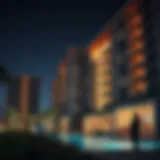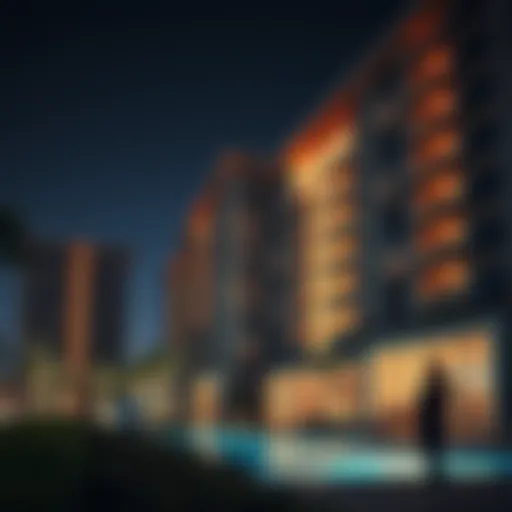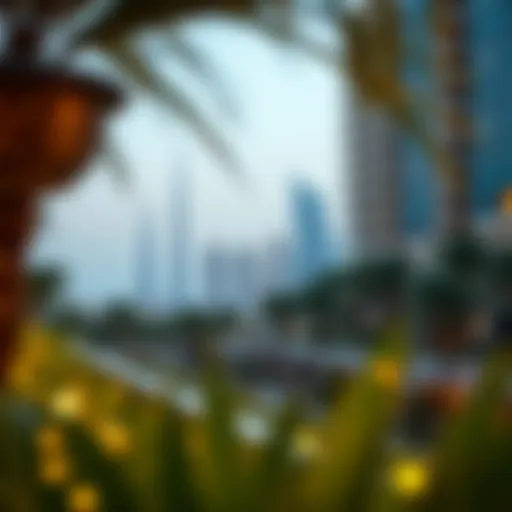Exploring Land and Sea: Dubai's Unique Identity
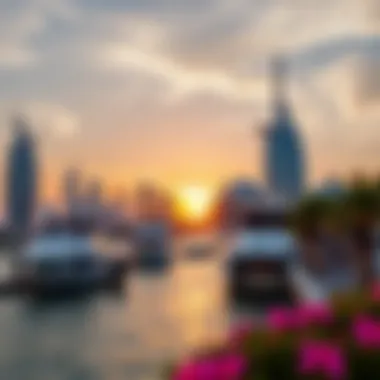
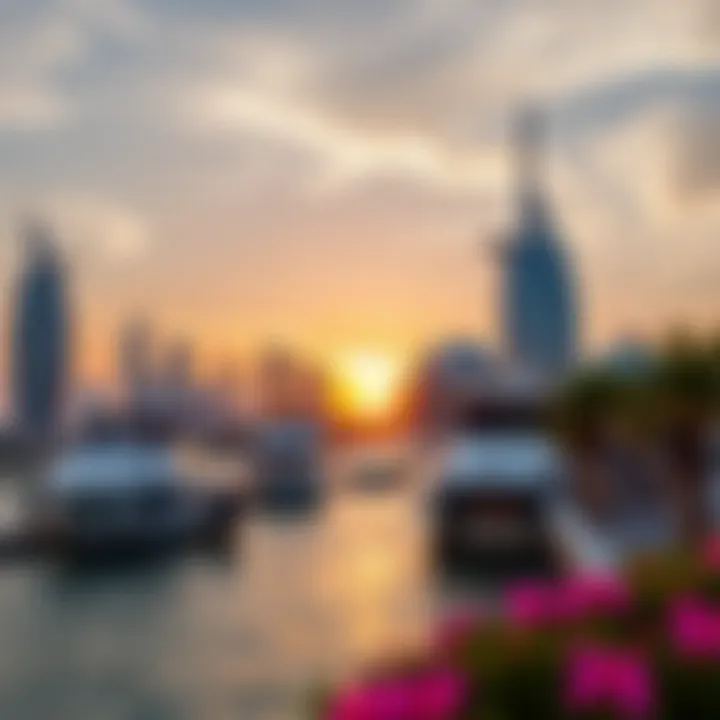
Intro
Dubai, a city etched in the desert sands and washed by the turquoise waves of the Arabian Gulf, represents a unique fusion of land and sea. The very essence of this metropolis can be grasped through the interplay of its sprawling urban developments and natural maritime beauty. This connection not only influences the city’s growth but also shapes its cultural narrative, environmental aspects, and recreational offerings. Understanding this duality is crucial for various stakeholders—from investors eyeing real estate opportunities to expatriates seeking a vibrant lifestyle.
As we dive into the complex layers of Dubai's environment, we'll explore how its land and sea are interlinked, offering insights into market trends, investment opportunities, and regional development. The implications of this relationship stretch far beyond mere geography, impacting economic prospects, leisure activities, and social interactions. By the end of this discourse, readers will have a comprehensive view of how these two realms coalesce to create a unique urban experience.
Market Trends
Current Market Analysis
The market landscape in Dubai oscillates dramatically between land and sea. With real estate prices often soaring near coastal developments, areas like Dubai Marina and Palm Jumeirah have become hot spots for both luxury living and investment. Current data suggests that properties in these regions command premium prices owing to their proximity to the waterfront. Recent analyses have indicated that even amid global economic uncertainties, the demand for waterfront properties has remained resilient. Much of this interest can be attributed to the appealing lifestyle these locations offer—be it stunning sea views or access to recreational activities.
Moreover, emerging sectors like marine tourism and waterfront entertainment are laying the groundwork for sustained growth. By tapping into these sectors, Dubai is not only boosting its economy but is also enhancing its global position as a prime destination for both tourists and investors alike.
Future Projections
Forecasts regarding the next decade paint a picture of continued expansion and transformation. It is anticipated that areas like Bluewaters Island will attract increasing investments, particularly since it boasts not just residences but also leisure and retail experiences right next to the sea.
Investors are expected to keep a keen eye on evolving patterns, particularly as infrastructure projects like the Dubai Water Canal further open up opportunities. These developments will likely stimulate additional projects that harmoniously blend urban spaces with natural landscapes, fostering an enhanced living experience. According to the Dubai Land Department, investment in waterfront real estate could potentially yield returns that outpace traditional land-based properties.
Investment Opportunities
High-Growth Areas
Identifying high-growth areas is crucial for anyone looking to capitalize on Dubai’s duality of land and sea.
- Dubai Marina: Known for its luxury apartments and lifestyle amenities, this area is a favorite among expatriates and tourists alike.
- Palme Jumeirah: The iconic palm-shaped island continues to attract high-net-worth individuals, making it a lucrative investment locale.
- Bluewaters Island: Home to landmarks like the Ain Dubai, this area is on the rise, promising significant returns as its commercial spaces develop.
Investing in these regions means more than just purchasing property; it’s about diving into a lifestyle that embraces the ocean while ensuring that every sunrise carries the promise of high returns.
Key Investment Strategies
Successfully navigating investments in both land and sea realms requires informed strategies:
- Market Research: Keep abreast of local trends, demographic shifts, and economic indicators.
- Diversification: Consider blending investments in both coastal and inland properties to hedge against market fluctuations.
- Engagement with Local Expertise: Partnering with seasoned brokers or local agencies can provide crucial insights and data to make informed decisions.
In summary, as Dubai continues to grow, the duality of land and sea provides countless opportunities for those savvy enough to sense the tides of change. For investors, brokers, expatriates, and buyers, the fusion of these two elements is much more than an environmental detail; it’s a core aspect of strategic positioning in a rapidly evolving marketplace.
"Understanding the duality of land and sea in Dubai is not just about geography; it's about grasping the essence of what makes this city thrive."
For more on Dubai's urban landscape and how it continues to shape investment trends, refer to Dubai Land Department and Britannica.
Prolusion to Dubai's Unique Landscape
Dubai, an avant-garde metropolis, showcases a harmonious relationship between land and sea, creating a distinctive landscape that is emblematic of modern urban development. Understanding this unique setting is critical, not just for local residents, but also for investors, brokers, expatriates, and researchers who are keen on grasping the intricate dance between these two elements. The interplay of the desert terrain and the Arabian Gulf is central to Dubai's identity, influencing everything from architecture to tourism, real estate, and cultural practices.
The importance of exploring the combination of land and sea cannot be overemphasized. On one hand, the vast stretches of desert present opportunities for investment in sprawling residential and commercial developments. On the other, the expansive coastline offers endless possibilities in water-based leisure and tourism. This duality shapes the growth trajectory of Dubai.
Furthermore, recognizing the consequences of urbanization on both land and marine ecosystems is imperative. Environmental sustainability is not just a buzzword but a necessity as development continues at a breakneck pace. Understanding these factors will help stakeholders make informed decisions and anticipate future trends.
The Geographic Context of Dubai
Nestled at the crossroads of Europe, Asia, and Africa, Dubai’s geographic positioning provides not only strategic advantages but also scenic beauty. Its landlocked components are often contrasted with the glimmering waters of the Arabian Gulf. This juxtaposition creates a milieu where desert life thrives alongside marine ecosystems, a delicate balance that is constantly evolving.
The city itself spans over 4,000 square kilometers, with its topography comprising the eastern Hajar mountains to the rugged southern desert. Amid these contrasting landscapes, coastal areas are particularly significant for trade, tourism, and their recreational uses.
- The desert contributes vital resources like sand used for construction, while the Gulf plays host to busy shipping routes that bolster Dubai's economy.
- Dubai's infrastructure reflects this unique geography, with roads and transportation networks designed to connect the land and sea, fostering coherent urban synergy.
In essence, the geographic context showcases the symbiotic relationship between Dubai's land and sea.
The Historical Significance of Land and Sea
Historically, the connection between land and sea in Dubai goes far beyond mere geography. It has roots that trace back to the founding of the city itself. Early settlers, primarily relying on fishing and trade via the sea, laid the foundations for what would become a thriving economy. The maritime culture was integral to the lifestyle, and this legacy is still visible today.
As trade routes flourished, Dubai transformed from a small fishing village into a bustling port city. Notable historical landmarks, like the Dubai Creek, served as arteries of commerce, allowing traders to navigate between land-based markets and their sea counterparts.
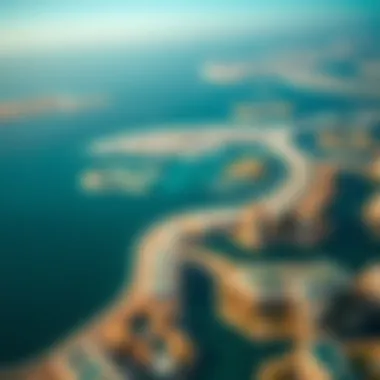

"The relationship between the desert and the sea is more than just geography; it’s the backbone of Dubai's economic narrative."
Key historical elements include:
- Pearl Diving: Once the source of wealth, native divers would venture into the sea, highlighting the community's dependence on marine resources.
- Trade Links: With a rich maritime history, Dubai built connections that extended across the Arabian Peninsula and beyond.
Land Development in Dubai
The evolution of Dubai into a global powerhouse can be traced back to its land development strategies. The harmony between urbanization and environmental consciousness encapsulates the spirit of the city. As industry and population burgeon, the management of land becomes pivotal not just for infrastructure but also for the essence of Dubai's identity. From soaring skyscrapers to pristine beachfronts, the approach to land development reflects a commitment to sustainability and innovation. This section delves into the various facets that define Dubai’s land development, shedding light on real estate trends and urban planning nuances.
Real Estate Growth and Trends
Residential Projects
Residential projects form the backbone of Dubai’s booming real estate market. By focusing on creating diverse housing options, this development sector directly influences the city’s appeal to expatriates and investors alike. Projects such as Emaar's Dubai Hills Estate or Dubai Creek Harbour exemplify significant trends—combining luxury with accessibility. A defining characteristic of these residential offerings is their community-centric designs, often featuring parks, retail outlets, and schools within close proximity.
The unique feature of these projects is their ability to cater to a wide variety of lifestyles, from young professionals seeking urban living to families looking for spacious homes in serene environments. However, the demand for residential spaces can lead to oversupply in certain areas, potentially affecting long-term property values.
Commercial Developments
Commercial developments in Dubai have been characterized by ambitious projects that cater to the growing business landscape. Zones like the Dubai International Financial Centre and Dubai Silicon Oasis serve as epicenters for commerce and innovation. These developments are vital for creating a competitive business environment that attracts multinational corporations and start-ups alike.
The key feature of commercial developments is their integration of state-of-the-art facilities with accessibility to key transport links. This focus fosters a conducive environment for businesses. However, each new commercial project must be carefully planned to avoid congestion and redundancy.
Luxury Properties
Luxury properties in Dubai are not merely about extravagant living but signify a lifestyle choice embraced by global elites. In areas such as Palm Jumeirah or Downtown Dubai, luxury is coupled with unique design and exclusive amenities. This specific aspect of the market has seen significant growth, making properties in these locations highly desirable.
What sets luxury properties apart is their intrinsic value, often tied to their exclusivity and breathtaking views. They serve as a status symbol for affluent buyers but can also become challenging during market downturns, as seen in previous economic shifts.
Urban Planning and Infrastructure
Transportation Networks
Robust transportation networks are foundational to the urban experience in Dubai. From the expansive Dubai Metro system to extensive road networks, the city's infrastructure mirrors its ambitious growth plans. Improved connectivity not only enhances mobility for residents but also boosts economic activity by linking businesses with consumers.
A prominent feature of these transportation developments is their focus on sustainability and innovation, such as electric buses and bike-sharing schemes. However, rapid urban expansion can strain existing systems, necessitating continuous upgrades to accommodate an ever-growing population.
Public Amenities
The provision of public amenities is essential in making Dubai a livable city. Schools, healthcare facilities, and community centers enhance the quality of life for residents. Projects like the Dubai Parks and Resorts demonstrate the commitment to creating entertainment and leisure spaces that cater to the community's diverse needs.
By prioritizing public amenities, Dubai positions itself as a city that values community well-being. Nonetheless, the allocation of resources towards these amenities needs to be balanced against ongoing real estate ventures to meet fast-growing demands without overextending budgetary limits.
Green Spaces
Green spaces play a crucial role in improving urban livability while mitigating the effects of rapid urbanization. Parks like Safa Park and Al Barsha Pond Park serve as critical recreational areas, promoting physical activity and social interaction among residents. Furthermore, they enhance biodiversity and contribute to the overall environmental health of the city.
The key characteristic of Dubai's green spaces is their multifunctionality; they provide recreational areas while also incorporating sustainable practices, such as water conservation techniques. However, the challenge lies in spatial planning to ensure that such spaces are not overshadowed by high-density developments, which could lead to a significant reduction in biodiversity and public enjoyment.
Marine Influence on Dubai's Development
The Arabian Gulf plays a pivotal role in shaping Dubai's identity, serving not just as a backdrop but as a vital element in its growth and engaging interaction between land and sea. This interdependence is reflected in trade, tourism, and recreational activities, creating a powerful synergy that supports Dubai’s aspirations as a global hub. Given the unique geographic position of the region, the sea is not only an aesthetic feature but also the lifeblood of the city's economy and lifestyle.
Impact of the Arabian Gulf
Trade and Commerce
The proximity to the Arabian Gulf offers Dubai unique advantages for trade and commerce. Historically, the city has leveraged its coastal position to become a major shipping and logistics hub. The bustling ports, such as Jebel Ali, serve as critical gateways for goods entering and leaving the Middle East.
- Key Characteristic: One of the defining traits of Dubai's trade is the free zone status, which attracts numerous international businesses.
- Benefits of Trade: Businesses enjoy tax exemptions and full ownership, making it a popular choice.
- Unique Features: The rise of e-commerce in recent years also reflects this strong marine influence, with many companies operating from the area to ship globally.
- Disadvantages: However, the reliance on maritime trade can be problematic. Economic fluctuations or restrictions related to marine transport can create vulnerabilities for the local economy.
Tourism Opportunities
Tourism is another significant aspect influenced by the Arabian Gulf. With its stunning beaches and turquoise waters, Dubai has become a recreational paradise, drawing millions of tourists annually.
- Key Characteristic: The luxurious resorts along the coastline create a narrative of exclusivity and opulence.
- Benefits of Tourism: High tourism numbers provide a steady revenue stream for local businesses and create jobs.
- Unique Features: Unique activities, such as the Dubai Marina, where visitors can indulge in watersports, have become highlights for tourists.
- Disadvantages: Yet, this heavy dependence on tourism can lead to fluctuations. The recent global disruptions have posed challenges to maintaining this influx.


Environmental Considerations
While the marine influence has driven prosperity, it also raises numerous environmental concerns. The ecological balance of the Arabian Gulf is threatened by development, pollution, and climate change.
- Key Characteristic: Coastal development must balance economic growth with ecological sustainability.
- Benefits of Environmental Awareness: Increased awareness has led to significant efforts in marine conservation and sustainable practices, such as initiatives to protect coral reefs.
- Unique Features: Projects, like the Dubai Turtle Rehabilitation Project, exemplify how the city is taking steps towards protecting its marine life.
- Disadvantages: However, the challenge remains daunting. The need for infrastructural advancements often conflicts with the conservation of natural resources.
Waterfront Developments
Beachfront Properties
Beachfront properties in Dubai have become sought-after real estate options, showcasing the merge between luxury living and marine influence.
- Key Characteristic: The stunning views of the Arabian Gulf offer buyers a blend of comfort and prestige.
- Benefits of Beachfront Living: Increased property values and a high demand for waterfront living highlight the appeal.
- Unique Features: Developments such as the Palm Jumeirah exemplify extreme engineering in real estate that captivates buyers.
- Disadvantages: On the downside, exclusive prices can alienate potential buyers, limiting opportunities to a wealthy clientele.
Marinas and Yacht Clubs
Marinas and yacht clubs symbolize the luxury lifestyle that Dubai aims to portray. The potential for both leisure and business is immense.
- Key Characteristic: Access to concierge services and exclusive events cater to high-net-worth individuals.
- Benefits of Marinas: They stimulate tourism and provide an avenue for personalized leisure experiences.
- Unique Features: Facilities like the Dubai Marina Yacht Club create a haven for boat enthusiasts and social gatherings.
- Disadvantages: However, the elite nature of these facilities can sometimes diminish inclusivity, limiting access for average residents.
Recreational Facilities
Recreational facilities along the coast enrich the social fabric of Dubai, drawing not just tourists but also residents who enjoy diverse leisure options.
- Key Characteristic: Integrated spaces like parks and boardwalks facilitate interactions among community members.
- Benefits of Recreational Developments: Promoting health and well-being among citizens through diverse activity options.
- Unique Features: The beach clubs, water parks, and outdoor cinemas provide varied experiences that cater to all ages.
- Disadvantages: Nevertheless, over-reliance on these facilities can lead to overcrowding, especially during peak seasons.
By understanding the intricate dynamics between marine developments and the land-oriented growth in Dubai, we can appreciate how this duality not only shapes the city’s economic landscape but also influences its culture and community.
Cultural and Social Dimensions
Understanding the cultural and social dimensions of Dubai's landscape reveals much about how land and sea interweave within the life of the city. The interplay between these two elements greatly influences not only the architecture and urban planning but also the daily lives of residents and visitors. Recognizing this duality helps to appreciate the city’s unique identity, where tradition coexists with innovation.
Lifestyle Choices Influenced by Geography
Land-Based Activities
Land-based activities in Dubai hold significant weight in determining the local lifestyle. With the sprawling desert just beyond the city, options abound for lovers of outdoor adventures. Hiking in the Hajar Mountains, dune bashing, and sandboarding offer thrilling experiences that connect residents with their arid surroundings. This geographical focal point provides a unique backdrop for exploring the local flora and fauna, enriching the community spirit.
The charm of land-based activities lies in their adaptability. Whether it’s the community-organized athletics or weekend barbeques in the parks, these activities foster social ties that strengthen neighborhood bonds. Popularity springs from their availability, giving residents numerous opportunities to partake in wellness pursuits while enjoying the scenic desert landscape.
However, the time commitment and climate can present challenges. The scorching summer heat discourages individuals from engaging in outdoor pursuits, limiting participation at peak times.
Water-Based Leisure
Conversely, water-based leisure activities build a contrasting yet complementary lifestyle. Dubai's coastline offers residents a refreshing escape from the mainland heat. Whether it’s jet skiing along the Arabian Gulf or relaxing on public beaches like Jumeirah, water-based pursuits enrich the urban experience. The vibrant beach culture showcases an openness and diversity that attract both locals and expatriates.
Water-based activities exemplify an essential aspect of Dubai's identity—luxury. Yacht parties and marine sports add an appealing flair to leisure, reflecting a lifestyle that many aspire to. However, this luxury often comes at a price, potentially alienating those not in a position to indulge in such pastimes.
Community Engagement
The essence of community engagement in Dubai cannot be overstated; it acts as a bridge uniting disparate cultures and backgrounds. Public events on the waterfront, including cultural festivals and artisanal markets, highlight the community’s vibrancy and foster social interaction. Moreover, waterfront parks facilitate family-oriented gatherings, bridging gaps between local traditions and international influences.
Community engagement emboldens residents, instilling pride in their multifaceted identity amidst rapid development. Nevertheless, the transient nature of many expatriate communities presents challenges in maintaining long-lasting social ties. This ebb and flow of populations may hinder the depth of community bonds.
The Role of Waterfronts in Architecture
Iconic Structures
Dubai's skyline is peppered with iconic structures that resonate with the duality of land and sea—a remarkable combination of engineering prowess and artistic vision. Buildings like the Burj Al Arab stand not only as luxurious hotels but also as symbols of the city’s ambition. Their locations along the coast enhance aesthetic appeal and create a narrative intertwining land and marine elements.
Such structures contribute to Dubai’s allure, drawing tourists and investors alike. They serve as backdrops for social activities and cultural events, creating spaces where land meets water in stunning harmony. Still, the building methods used here sometimes raise concerns about sustainability and environmental impact, setting up a debate between beauty and eco-friendliness.
Sustainability Practices
Sustainability practices in Dubai reflect the growing awareness around environmental responsibility. With architectural innovations emphasizing energy-efficient designs and eco-friendly materials, a new trend emerges where structures are built with the land and sea's well-being in mind. The development of green roofs and the incorporation of solar panels illustrate efforts to mitigate construction's ecological footprint.
Such efforts might seem sacrificial in a city driven by luxury and opulence, yet they inspire hope for a balanced future. However, the rapid pace of urbanization sometimes overlooks these principles, risking the delicate balance sought in this desert metropolis.


Artistic Representations
Artistic representations of Dubai often celebrate its maritime roots, influencing how residents interact with their environment. Murals depicting historical fishing practices, sculptures paying tribute to seafarers, and installations near the waterfront resonate with the collective memory of both the land and sea.
These artistic expressions enrich public life and provide a platform for cultural dialogues among diverse communities. While offering depth to the landscape, these installations also invite scrutiny concerning their relevance and the narrative promoted by the city's growth.
Challenges and Opportunities
Dubai’s transformation into a global city is a marvel of modern development. However, the duality of its land and sea creates a unique set of challenges and opportunities that must be navigated carefully. Understanding these dynamics is not just for the policymakers; investors, brokers, and expatriates alike can glean vital insights into the future of this vibrant city.
Environmental Sustainability
Climate Change Impacts
Climate change touches every corner of the globe, and its effects are especially noticeable in coastal cities like Dubai. With rising sea levels threatening the extensive coastline, the challenge is more than just environmental; it’s about the very essence of Dubai’s growth. The Arabian Gulf can be temperamental, and the increased temperatures can also lead to more extreme weather patterns.
The saline intrusion into freshwater aquifers is a key characteristic that waterfront developers need to consider. This issue underscores the need for innovative building techniques and sustainable design practices to protect investments. There's a strong motivation for developers to embrace resilient infrastructures that adapt to these changes, offering a more secure future for the city’s growth.
Pollution Management
Pollution is a pressing concern for any bustling metropolis, and Dubai is no exception. The urban sprawl, coupled with heavy tourist traffic, brings potential pitfalls associated with water and air pollution. The key here is effective pollution management strategies that can mitigate these risks. For instance, regulating marine activities and monitoring industrial discharges into the Gulf can heavily contribute to maintaining a healthy ecosystem.
Efforts to improve waste management systems play a pivotal role here. This strategy can reduce waste that ends up polluting waterways while also recycling materials. Such initiatives not only better the environment but also enhance the city’s image as a responsible destination for investors and tourists alike.
Conservation Efforts
In an era where even the most developed regions are scrutinized for their ecological footprint, conservation efforts provide a counterbalance. These initiatives can involve restoring natural habitats or creating marine protected areas within the Gulf. By preserving these ecosystems, Dubai not just showcases its commitment to sustainability but also enhances biodiversity. The unique coral reefs and marine life can be a huge draw for eco-tourism, providing new opportunities for economic growth.
The challenge lies in funding and executing these projects effectively. While there's great potential, balancing the need for development with conservation efforts requires a deft touch.
Balancing Development with Nature
As the city continues its ambitious growth, the balance between development and nature becomes increasingly vital. A careful approach can yield substantial benefits for both sectors.
Regulatory Frameworks
Building robust regulatory frameworks is paramount in fostering an environment where development goes hand-in-hand with conservation. Clear guidelines ensure that new constructions consider environmental assessments and comply with regulations designed to protect Dubai’s unique ecosystems. This proactive approach can prevent adverse impacts from projects and is appealing to investors looking for stability.
However, bureaucracy can sometimes slow down the process. Striking the right balance is essential to enhance growth while safeguarding natural resources.
Community Initiatives
Grassroots organizations play a crucial role in engaging residents and raising awareness about sustainability issues. These community initiatives inspire local participation and encourage individuals to take ownership of their environments. This not only promotes environmental stewardship but also builds a strong community identity. Successful initiatives often result in increased property values and draw in new residents seeking a sense of belonging.
Engagement from the community leads to higher accountability from the authorities and developers. While there can be challenges in mobilizing resources, the resulting benefits of a more cohesive and environmentally-conscious community are undeniable.
Future Prospects
Looking ahead, the future prospects for Dubai hinge on how effectively the challenges posed by land and sea are addressed. Investment in sustainable technologies, alongside a commitment to green initiatives, will set the tone for what’s to come. Cities worldwide are leaning towards sustainability, and Dubai has the potential to emerge as a leader in this domain.
The unique features that combine Dubai’s land and marine development can create ample opportunities for innovation and tourism while ensuring an attractive living environment for its residents. As partners in progress, every stakeholder—from developers to local communities—will find a place in shaping Dubai’s vibrant future.
"The beauty of Dubai lies not just in its skyline but in the innovative partnerships that sustain its balance between ambition and nature." - Local Urban Planner
End
As we bring our exploration of Dubai's captivating landscape to a close, it's essential to spotlight the profound relationship between land and sea. This dynamic duo underpins the very structure of Dubai, not just physically but also culturally and economically. The land, with its striking skyline and rapid development, meets the vast, shimmering Arabian Gulf, creating a unique tapestry of life that influences residents, investors, and tourists alike.
The Future of Land and Sea
Looking ahead, the future of Dubai's land and sea presents a dual opportunity filled with promise and challenges. It’s a balancing act that the city must master. As urban expansion continues, authorities are increasingly aware of the need for sustainable development practices. Protecting marine ecosystems while pushing for real estate growth will be critical. This can be achieved through thoughtful urban planning which integrates nature into infrastructure. For investors and residents alike, understanding how these trends evolve will be key to capitalizing on future opportunities.
- Emerging Technologies: Innovations in environmental monitoring and construction can provide a pathway for sustainable development, ensuring that the growth of land does not compromise the health of seascapes.
- Evolving Waterfronts: As Dubai embraces more waterfront projects, these spaces can become cultural hubs that promote ocean awareness and community engagement, blending leisure and education in accessible environments.
Final Thoughts on Dubai's Development
Dubai stands at a pivotal moment, where every decision made today echoes into the future. The integration of land and sea offers a lens through which to view the city's evolution. It’s not merely about expansion but about creating an environment where life thrives—both on solid ground and beneath the waves. With its rich history and forward-thinking approach, Dubai can emerge as a model for how urban centers can coexist sustainably with natural environments.
"Sustainability is not just an option; it's our responsibility. The future of our world hinges on how we respect and manage our resources today."
In summary, the duality of land and sea in Dubai is more than just a geographical quirk; it’s a vital component shaping the city's narrative. Investors, brokers, expatriates, buyers, and researchers must pay heed to these insights, as they forge paths into this dynamic landscape. For further reading on urban sustainability topics, you can explore resources like Wikipedia and Britannica.
By keeping an eye on the interplay between these realms, one can truly appreciate and navigate the complexities of Dubai's transformative journey.
